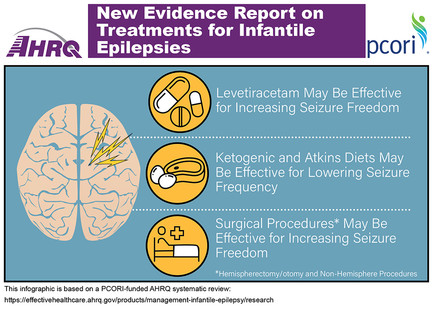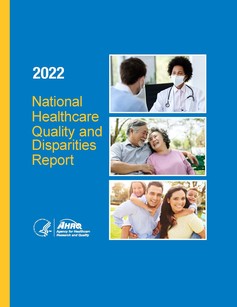| November 15, 2022, Issue #839  Access more information on this topic in the associated systematic review.  AHRQ has released its 2022 National Healthcare Quality and Disparities Report (NHQDR), which provides policymakers, health system leaders and the public with a statistical portrait of how effectively the healthcare delivery system provides safe, high-quality and equitable care to all Americans. The report's "Portrait of American Healthcare" offers numerous important insights, including: - Life expectancy in the United States lags behind life expectancy in similarly developed countries, and the gap has grown since 1980.
- COVID-19 was the third leading cause of death in 2020.
- A shortage of primary care health professionals compromises access to services in more than 60 percent of U.S. counties.
- Social determinants of health may have a stronger influence on people's health outcomes than clinical services provided by healthcare delivery systems.
This year's report includes data on four Special Emphasis Topics: maternal health; child and adolescent mental health; substance use disorders; and oral health. Access the full report plus NHQDR Data Tools, which allows users to explore trends and analyses using data from the report. |  The Spectrum Score, a metric for calculating the scope of antibiotic prescribing, may offer an important quantitative measurement to inform clinical prescribing patterns, guide antibiotic stewardship programs and evaluate long-term impacts of antibiotic practice in patients with suspected infection and sepsis, according to a study in Medicine. AHRQ-funded researchers applied the metric, developed to gauge the impact of antibiotic medications, to hospitalized patients with suspected infection or sepsis. Of 364,506 emergency department admissions, about 44 percent had suspected infection and about 56 percent had confirmed sepsis. Deaths were higher among those with sepsis compared with those with suspected infection (8.4 percent vs. 1.2 percent). Higher antibiotic global spectrum scores were associated with an increased risk for hospital mortality even after controlling for patient characteristics and severity of illness. The researchers concluded that Spectrum Score was effective in measuring the differences in antibiotic exposure among individual patients, between suspected infection and sepsis populations, over the course of hospitalization and across infection sources. Access the abstract. |  An AHRQ-funded study published in Nursing Research found that compliance with nurse staffing guidelines can predict positive hospital exclusive breast milk feeding rates, a National Quality Forum measure of newborns fed only breast milk from birth through hospital discharge. Reviewing data from 2,691 nurses who worked various hospital shifts at 184 hospitals in 29 states, researchers analyzed the relationship between nurse-reported staffing and missed nursing care as well as breast milk feeding. A positive exclusive breast milk feeding rate was partially due to labor nurses facilitating skin-to-skin mother–baby care and breastfeeding within one hour of birth. These findings are important because research indicates that breast milk has substantial life course health benefits for not only newborns consuming it but also for birthing people providing it. Researchers also found a negative association between missed nursing care and breast milk lactation within the first hour of birth and recovery care. Access the abstract. | AHRQ's Patient Safety Network (PSNet) highlights journal articles, books and tools related to patient safety. Articles featured this week include: Review additional new publications in PSNet's current issue or access recent cases and commentaries in AHRQ's WebM&M (Morbidity and Mortality Rounds on the Web).  A new guide from the AHRQ Academy provides research findings, tools and resources for integrating perinatal behavioral health services in primary care and other practice settings. The Academy supports the integration of behavioral health into care for patients using substances, particularly opioids, and for those with mental health conditions. The new guide helps practices support screening, assessment, treatment, management and continuing care for pregnant and postpartum women with behavioral health conditions. Access the guide. | | AHRQ in the Professional Literature Association between care fragmentation and total spending after durable left ventricular device implant: A mediation analysis of health care-associated infections within a national Medicare-Society of Thoracic Surgeons INTERMACS linked dataset. Kim KD, Funk RJ, Hou H, et al. Circ Cardiovasc Qual Outcomes. 2022 Sep;15(9):e008592. Epub 2022 Sep 6. Access the abstract on PubMed®. The need for electronic health records to support delivery of behavioral health preventive services. Huffstetler AN, Epling J, Krist AH. JAMA. 2022 Aug 23;328(8):707-8. Access the abstract on PubMed®. Association of high-deductible health plan enrollment with spending on and use of lenalidomide therapy among commercially insured patients with multiple myeloma. Jazowski SA, Wilson L, Dusetzina SB, et al. JAMA Netw Open. 2022 Jun 1;5(6):e2215720. Access the abstract on PubMed®. Adjusting for social risk factors in pediatric quality measures: adding to the evidence base. Bucholz EM, Toomey SL, McCulloch CE, et al. Acad Pediatr. 2022 Apr;22(3s):S108-s14. Access the abstract on PubMed®. Physician response to COVID-19-driven telehealth flexibility for opioid use disorder. Beetham T, Fiellin DA, Busch SH. Am J Manag Care. 2022 Sep;28(9):456-63. Access the abstract on PubMed®. Maternal, infant, and child health outcomes associated with the Special Supplemental Nutrition Program for Women, Infants, and Children: a systematic review. Venkataramani M, Ogunwole SM, Caulfield LE, et al. Ann Intern Med. 2022 Oct;175(10):1411-22. Epub 2022 Sep 6. Access the abstract on PubMed®. Automated telephone follow-up programs after hospital discharge: do older adults engage with these programs? Harrison JD, Sudore RL, Auerbach AD, et al. J Am Geriatr Soc. 2022 Oct;70(10):2980-7. Epub 2022 Jun 29. Access the abstract on PubMed®. Patient judgments about hypertension control: the role of patient numeracy and graph literacy. Shaffer VA, Wegier P, Valentine KD, et al. J Am Med Inform Assoc. 2022 Oct 7;29(11):1829-37. Access the abstract on PubMed®. Contact Information For comments or questions about AHRQ News Now, contact Bruce Seeman, (301) 427-1998 or Bruce.Seeman@ahrq.hhs.gov. |








No comments:
Post a Comment